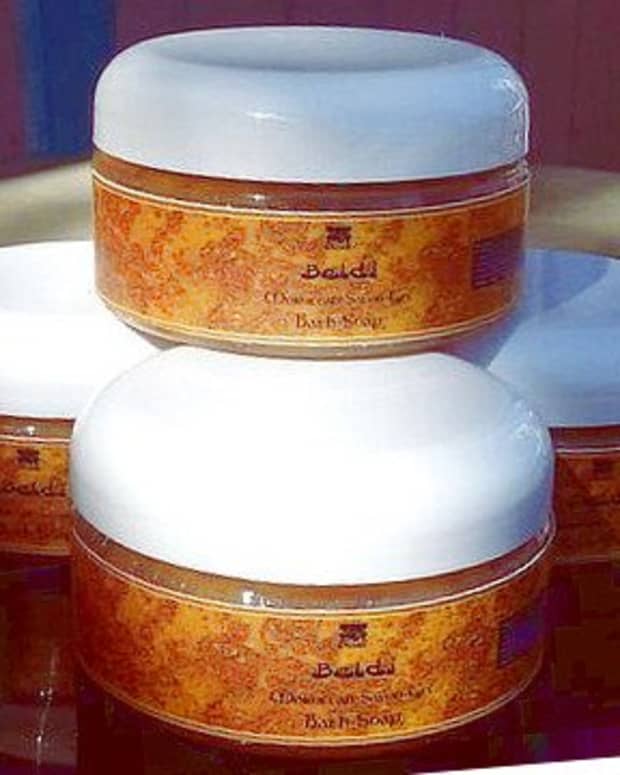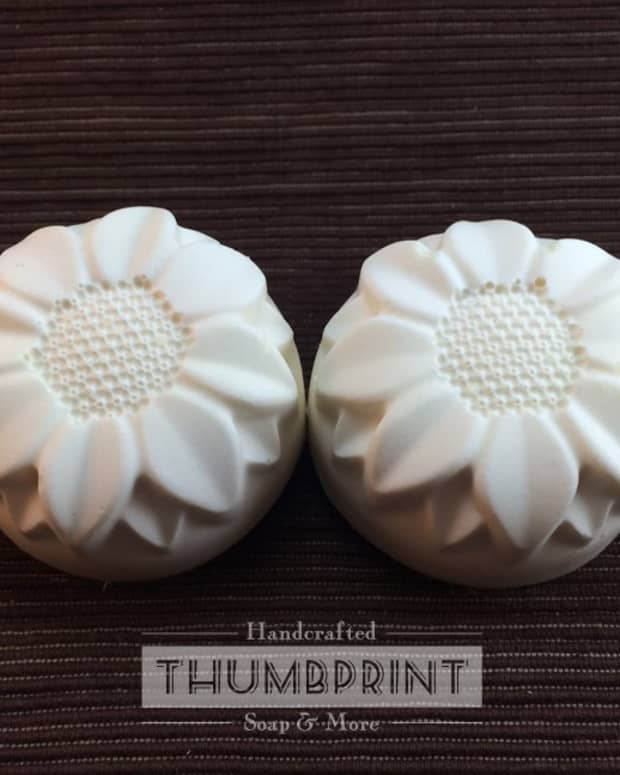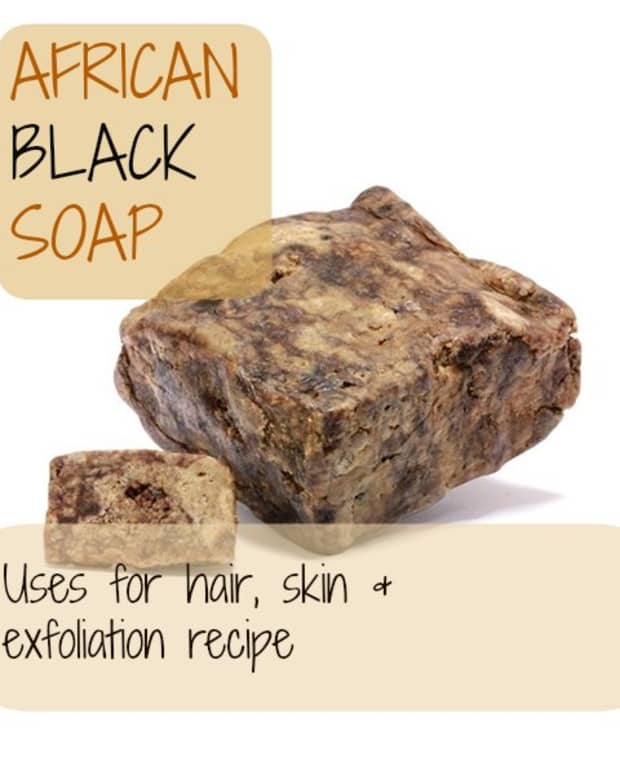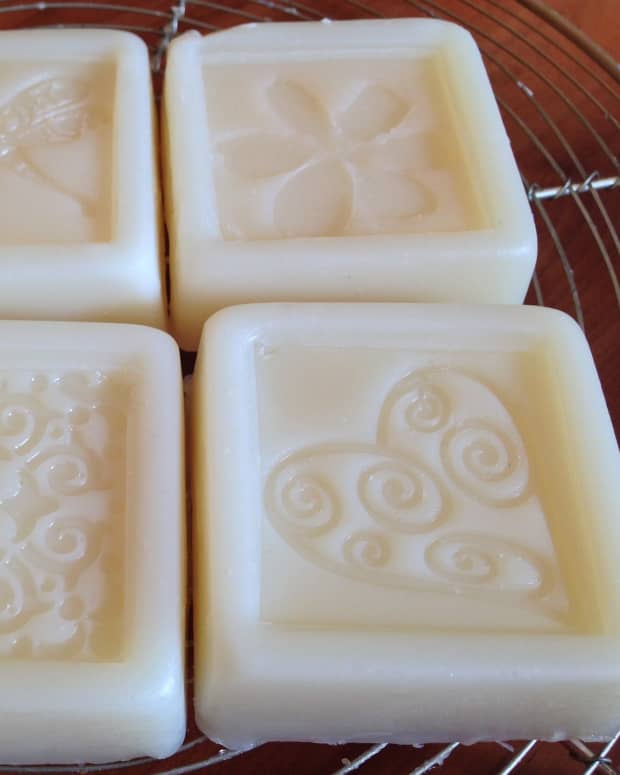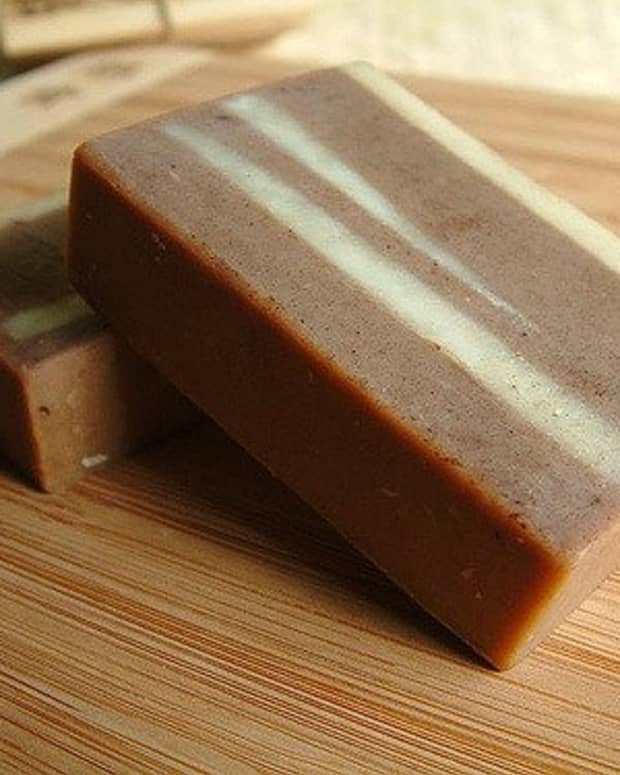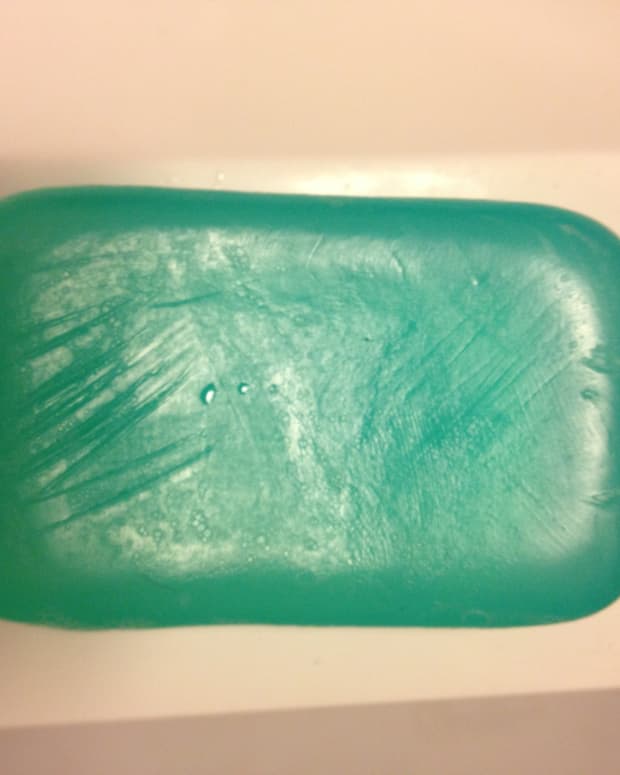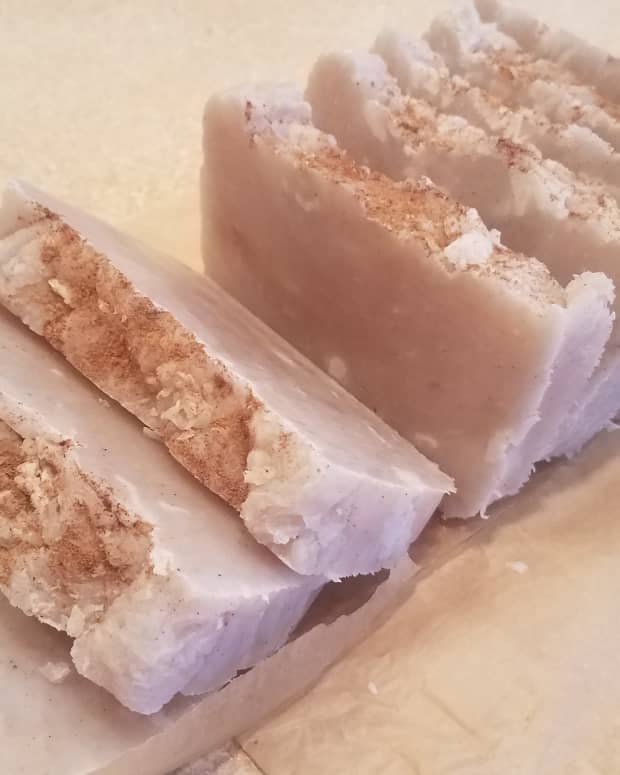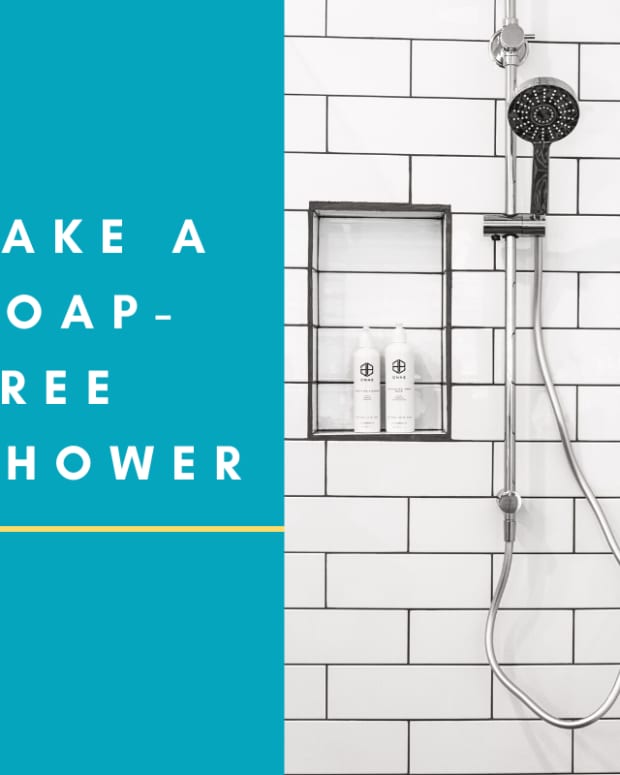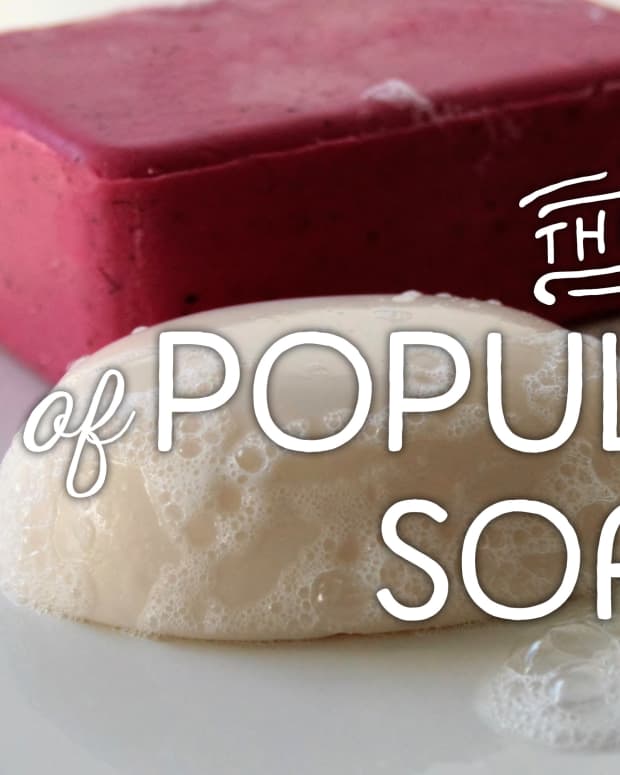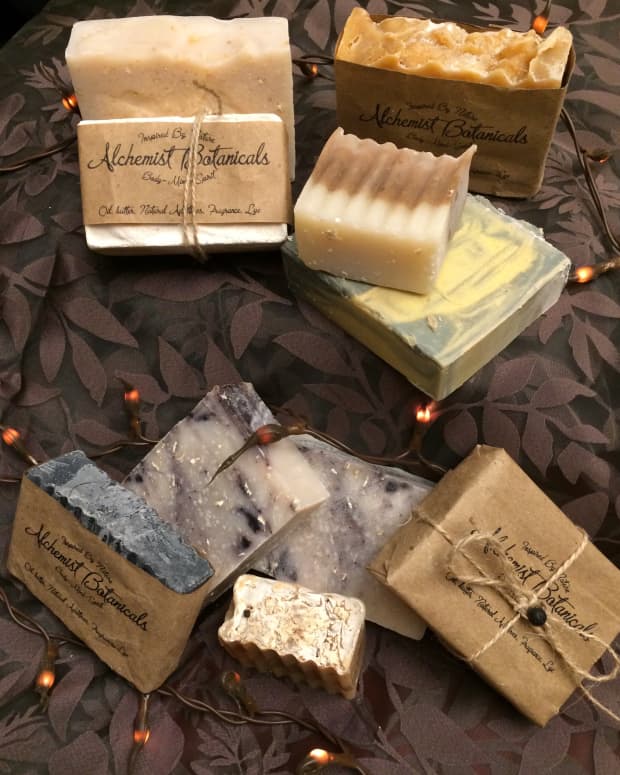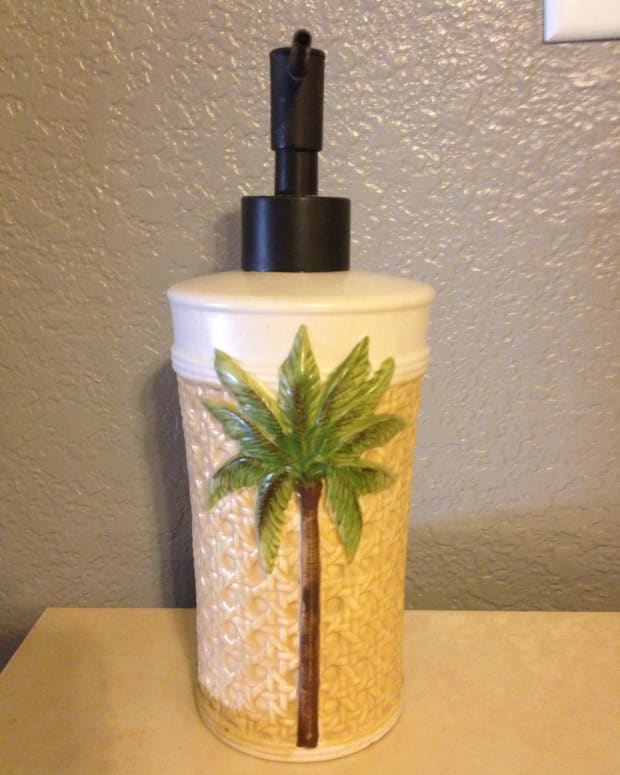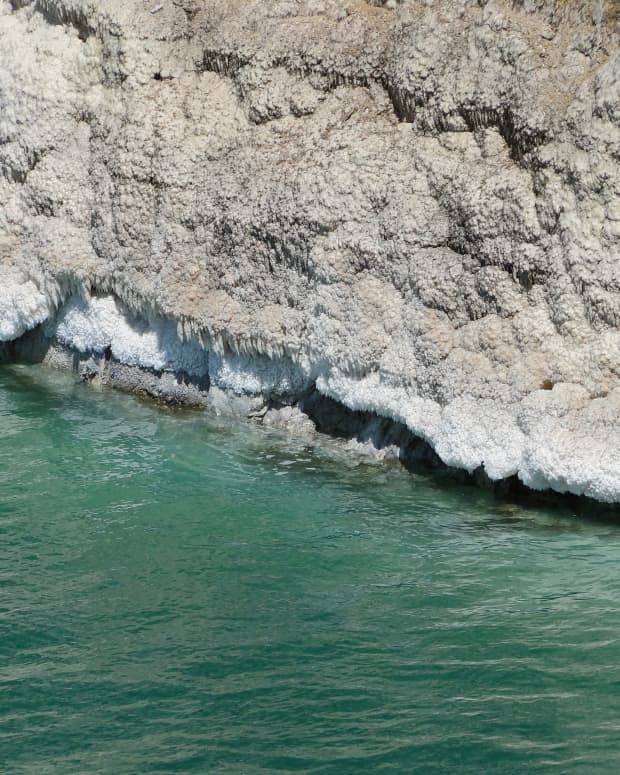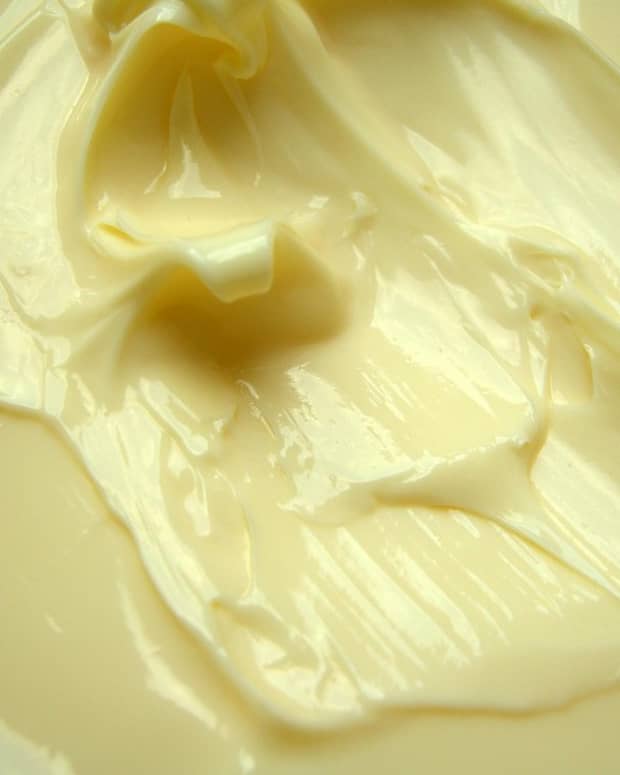How to Make a Luxury Beldi Facial Soap
Sharon is a largely self-taught herbalist who has been growing and studying herbs and making herbal preparations for several decades.
I have two daughters with dry and sensitive skin, and from the time I first began making soaps and body care products, my focus was on formulating products that would help relieve dry, itchy skin and eczema, and help keep delicate skin look youthful and dewy.
One of my daughters runs the family farmette and is outdoors in all kinds of weather: rain or shine, heat or cold. She grows a garden, milks goats, feeds the critters, keeps bees, and works on fencing and building sheds, chicken tractors, and automatic hog feeders.
When she told me she was worried that she'd start looking like a "weathered old farm woman," I decided to develop a facial soap that would preserve her delicate complexion. To be honest, she looks a lot less like a "weathered old farm woman" than she does like proof of the words to the old folk song, "It's dabblin' in the dew makes the milk-maid fair." But I wanted to make my contribution to keeping it that way--plus maybe try to come up with something that would improve the appearance of my aging face.
What Is a Facial Soap and How Is It Different from a Body Soap?
When a person sets out to develop a formula for facial soap, the first step is to decide on the special properties it should have, as distinct from a body soap.
- Facial soaps usually have a high superfat percentage, so that the soap does not strip oils from the complexion, but replenishes them. Most soap makers feel that a facial soap should be at least 8% superfat--and that is a minimum.
- Many soap makers feel that care should be taken to use oils with a low comedogenicity--that is, oils that are believed to be less likely to clog pores and thus promote acne. There is some controversy as to whether comedogenicity is a "real thing." I am on the fence about comedogenicity. If this is a concern for you, you might want to choose a recipe that uses little or no coconut oil, which has a moderately high comedogenicity rating. (For example, you could make a traditional Beldi using 100% olive oil.) Eliminating coconut oil from a recipe is problematic, in that soaps made without coconut oil will generally lather poorly. Another ingredient commonly used in soap making that has a moderately high comedogenicty rating is cocoa butter--a butter that I consider essential in bar soaps, because it gives them "substance" and a pleasing texture. Salt is thought to be highly comedogenic. While I'm not sure I believe this, I would suggest adding sugar, rather than salt, if you'd like to include an exfoliant in scrubs and facial soaps like the one below. My recipe below is a soft, gooey soap, and you can easily mix a little sugar with it for exfoliation.
- Oils used as superfats should offer special skin benefits. It's nice if some of the more expensive "luxury" oils can be used, but it's not really necessary. Some oils contain natural antioxidants, skin-nourishing vitamins like A, E, or C, skin-healing fatty acids like gamma-linolenic acid, and many other components. Some oils, such as grapeseed, are slightly astringent, making it good for acne-prone skin. Researching and choosing superfatting oils is the most interesting aspect of developing a facial soap.
- The fragrances used in facial soap should be essential oils that benefit skin. Fragrance oils should be avoided in both facial soaps and shampoos. I know from experience that fragrance oils are "double-plus-ungood" in shampoos. I've only used them a couple of times, when I first started making shampoos, and they resulted in "scalp crud." This leads me to believe that some--and perhaps all--fragrance oils are damaging to the more delicate areas of the skin, and this would include the face. Several essential oils, on the other hand, have special healing properties and/or are thought to rejuvenate skin, or benefit skin in other ways.
- Some additives are popular in facial soaps for acne. Activated charcoal is often used in soaps for acne, as is tea tree oil. Other types of additives have other benefits. Honey is sometimes added to soap, and if added to the cool-down phase, it will retain its benefits--and will also help improve lather. While some botanicals or botanical extracts offer specific skin benefits, my opinion is that the active principles are probably destroyed by contact with lye. Very finely ground dry botanical extracts of your choice could be incorporated into the recipe below, and should not result in spoilage--but if you add dry botanicals you might also want to add a preservative. Botanical extracts made with glycerin extraction could also be added in the cool-down phase, and should not result in spoilage of the product. You should probably not add water based extracts or herbal teas to this product, since you would be creating a partially diluted liquid soap (or maybe a fully diluted liquid soap, if you added enough water). Botanicals in water will create preservation problems. There are many commercially available additives that are nice additions to luxury soaps, such as Honeyquat, panthenol, or even sodium PCA. (You don't want to add sodium lactate, or you'll wind up with a bar soap.) Additive possibilities are nearly endless.
- Should a facial soap be made with oils that are very low in unsaponifiables? I am inclined to think this may be the best approach. Unsaponifiable residues of the oils in soaps might clog pores. So maybe it's is best to select oils that are low in unsaponifiables, when formulating a facial soap.
- In my opinion, a facial soap should be high in linoleic and linolenic acids--the fatty acids that are very beneficial to skin.
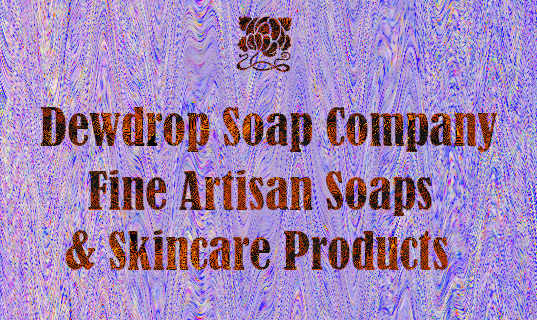
Finest all-natural artisan soaps, bath bombs, facial soaps, facial serums, and healing salves. The most luxurious bath and body products!
KOH Soaps versus NaOH Soaps
Besides my interest in making a really luxurious soap for my daughter's delicate skin, another reason I wanted to develop a facial soap was because I thought I was already onto something.
Sodium hydroxide (NaOH) soaps are the typical bar soaps that are now available almost everywhere (as distinct from "detergent bars" or syndet bars that have been more commonly sold in stores for the past fifty-plus years). NaOH soaps are the real bar soaps made by artisan soap makers, which have a lovely "feel" on the skin and are much less harsh than commercial "detergent bars." Many soap makers produce bars with a high amount of "superfat"--fats and oils that are not consumed during saponification, and which remain incorporated in the bar of soap, to moisturize skin as well as clean it. My own recipe for NaOH bar soaps has about a 20% superfat, which is very high. Remember, I formulated my soaps for dry and delicate skin. This recipe still does a wonderful job of cleansing skin, and many soap makers would consider a soap with such a high percentage of superfat to be a good facial soap.
But one year before Christmas I decided to make a batch of the very ancient--but newly stylish--Beldi soaps for Christmas presents. Beldi type soaps are believed to have originated in the Levant, many centuries ago. It is also sometimes called Moroccan black soap, or "Savon Noir." Like our American grandmothers' old-fashioned lye soap, thos soap was made with potassium hydroxide (KOH) derived from wood ashes, and is a soft soap that is a paste (or in some instances a goo), rather than a hard bar-type soap. Our American grandmothers usually hardened their lye soaps to make them into bars by adding salt, and the American version was most often made with lard or tallow that was readily available for soap making.
Traditional Beldi soaps, on the other hand, were made with olive oil--the material most readily available for soap making in the Middle East. Crushed olives are often incorporated into traditional Beldi soaps. These soaps were--and still are--traditionally used in Turkish baths, or hammams, though they are now a specialty of Morroco, rather than Turkey. They are applied to damp skin, left on the skin for ten minutes or so in the steam room, and then scrubbed of with a kessel, a coarse glove used for exfoliation.
Modern soap makers have embraced these soft "paste" or "goo" soaps and begun making their own adaptations of them, making use of the nearly endless variety of fats and oils available to today's soap maker. Deveoping interesting new formulas is what modern soap makers love to do. They also often like to give their creations as gifts--which was my plan, with this first batch. So everybody got some, plus I had quite a bit left over for myself.
My first venture into making Beldi was a fairly simple recipe, superfatted with a few luxury oils and scented with a nice fragrance oil (Brambleberry's Tahitian Vanilla, to be exact). It quickly became my preferred bath soap, giving skin an unusually nice "feel."
Eventually I began using it as a facial soap--and immediately noticed a marked improvement in my skin.
Even at my advanced age, I sill get blackheads and even occasional zits. These almost completely disappeared.
Is Beldi Soap Made with Potassium Hydroxide Better for Skin than Sodium Hydroxide Bar Soaps?
Many soap makers feel that soft soaps made with potassium hydroxide are more beneficial to skin than bar soaps made with sodium hydroxide, based on their experience in using such soaps. I did quite a bit of online research to try to find out if there is any known chemistry-related reason why this should be true, but came up empty.
I've noticed a huge difference in my skin from using Beldi soap, but thought this might be because even my first version was heavily superfatted with "luxury" oils. While my bar soap recipe is also heavily superfatted, the actual superfats that remain in the soap are some unknown combination of the oils included in the recipe, since I make cold-process soap--which means you can't choose your superfats. With hot-process soaps, superfats are added after saponification is complete, which means that the superfats will consist of the oils you have specifically chosen. These may be anything from sunflower oil, to hempseed oil, to some of the more exotic oils like borage oil, perilla seed oil, argan oil, or dozens of others.
Since Beldi is a hot-process soap, I revelled in the prospect of being able to choose the superfats I would incorporate into this soap, and I chose some pretty nice ones, even for the first batch. It thought this might be the only reason why using Beldi as a facial soap improved my skin so much.
Potassium hydroxide produces a soap whose chemistry is different than sodium hydroxide soaps. The the soap that results is composed of potassium salts of fatty acids. (Soap is a kind of "salt" from the standpoint of chemistry--the result of the chemical reaction between an acid and a base. Fats and oils are weak acids--composed of what are called "fatty acids.") The more common bar soaps result in sodium salts of fatty acids.
Another compound that is produced by the chemical reaction between either type of lye, whether NaOH or KOH, is glycerin. But the glycerin produced by KOH is chemically identical to the glycerin produced by NaOH.
According to one chemist I spoke with about this, the main difference between KOH soaps and NaOH soaps is that KOH soaps have greater solubility. But even this seemingly insignificant change in solubility changes how fats feel on the skin and how they interact. KOH soaps may have less of an ability to form micelles, resulting in a less harsh soap.
Also, NaOH soaps form a much stronger crystalline structure than KOH soaps--which is why NaOH soaps form a hard bar, and KOH soaps remain relatively fluid. NaOH bars soaps are usually composed of a combination of "more soluble" soap molecules and "less soluble" soap molecules. The "more soluble" soap molecules in bar soaps are at first largely bound within the soap's crystalline structure. That is, these "more soluble" soap molecules are mostly not present during use; they are tied up in the soap's crystalline structure. After a long cure--much longer than the recommended 4-6 week curing period for bars soaps--these "more soluble" soap molecules migrate out of the soap's crystalline structure. (This happens because water evaporation eventually results in "salting out" of the "more soluble" molecules.) So, with NaOH bar soaps, it takes quite a long time for them to cure sufficiently for the "more soluble" soap molecules to migrate out of the predominant crystalline structure (and into the "liquid phase" of the soap) to become available when the soap is used. It takes quite a long cure time for bar soaps to reach this point--probably 3 months to a year. Once this migration has taken place, the soap lathers better, lasts longer, and is milder to the skin.
KOH soaps have only a very weak crystalline structure, so that the "more soluble" soap molecules are immediately available during use. In other words, with KOH soaps you get the same effects you would by using a bar soap that has cured for a year or more, or long enough for the "more soluble" soap molecules to have largely completed their migration out of the soap's predominant crystalline structure and into the soap's "liquid phase."
Hence, with KOH soaps you get the "lathers better, milder to skin" effect from the get-go. Thus the well-known property of KOH soaps to be less irritating to the skin than NaOH soaps.
So there are some reasons to believe that the chemically different Beldi KOH type soaps are "better stuff" for skin. I do know that my skin responds better to Beldi soaps. Other soapmakers have mentioned the same results and some, like me, use only Beldi-type soaps for facial soaps.
My Beldi Recipe
I chose this recipe because it lathers well, even with a very high superfat--plus this is the recipe I use to make liquid soap shampoo, so I am very familiar with working with it. It is actually Liz Ardlady's shampoo bar recipe, which you can read about here: http://lizardladysoapinfo.blogspot.com/2014/06/so-you-want-to-make-bar-of-shampoo.html
Also, part of my thinking in selecting this recipe for a facial soap is that Liz formulated it to be very low in unsaponifiables--components of fatty acids that do not turn into soap, and are thus left on the skin. It seemed to me that unsaponifiable residues in soap might clog pores.
Liz's shampoo bar recipe is also very high in linoleic and linolenic acids, which are the "super good for skin" fatty acids.
As you can see, I went a little bit nuts with this recipe, including quite an array of rather fancy skin-loving essential oils. This is partly because I had already collected a bunch of luxury oils, over time, for use in lotions. You may not want to purchase eleven different expensive oils to make this--nor do you need to, to produce a very fine soap.
Any oils of your choice can be substituted for the superfats that are added after the cook. Just use 6.5 ounces of the oil or oils of your choice. For example, you could use 6.5 ounces of grapeseed oil, 6.5 ounces sunflower oil, or 6.5 ounces of hempseed oil. Or you could use a combination of more readily available oils of your choice, totaling 6.5 ounces. You will notice when you add the superfat oils that this is a LOT of oil! You will likely feel that the amount of oil is excessive. It isn't--just looks like it. This soap will still lather well, despite the very high superfat.
It's also perfectly okay to select fragrances of your choice. I chose specific essential oils for specific skin benefits. You may prefer others. I included litsea cubeba mainly to mask slightly unpleasant scent of the carrot seed oil, though litsea too has skin benefits.
Substituting apple cider vinegar (ACV) for the water to be mixed with lye is an idiosyncrasy of mine. ACV is said to improve lather and make a milder soap. It is perfectly okay to use water for this recipe, rather than ACV. This will lower the superfat slightly, but even when made with water, the superfat in this recipe is about 22%--very high. When made with ACV, the superfat is about 30%. (This is why it looks like such a huge amount when you add the superfats. It is a huge amount!) But even with this very high superfat, this soap gets skin squeaky clean.
I've divided the recipe into four stages: Oil Phase, Water Phase, After Cook, and Cool-Down, for the sake of simplicity.
Beldi Soap Recipe
OIL PHASE
- 8 ounces Canola
- 5.3 ounces Coconut Oil
- 1.1 ounces Castor Oil
- 0.8 ounces Mango Butter
- 0.8 ounces Sunflower Oil
- 4 ounces Glycerin
Read More From Bellatory
WATER PHASE
- 7.2 ounces ACV (apple cider vinegar)
- 3.9 ounces KOH
SUPERFATS TO BE ADDED AFTER COOK
You can substitute any oils of your choice for these. The oils you select should add up to a total of 6.5 ounces.
- 0.5 ounce Argan Oil
- 0.5 ounce Borage Oil
- 0.5 ounce Black Cumin Seed Oil
- 0.5 ounce Perilla Seed Oil
- 1 ounce Safflower Oil
- 0.5 ounce Tamanu Oil, after cook
- 0.5 ounce Flaxseed Oil, after cook
- 0.5 ounce Meadowfoam oil
- 0.5 ounce Hempseed oil
- 0.5 ounce Sea Buckthorn Oil
- 1 ounce Pomegrante Oil
TOTAL SUPERFATS = 6.5 OUNCES
COOL-DOWN PHASE
- 1.8 ounces Honeyqaut ( = 4.9%)
- 1.8 ounces DL-Panthenol ( = 4.9%)
2 Ounces of Fragrance:
- 1 ounce Bulgarian Lavender
- 0.5 ounce Geranium
- 0.5 ounce Carrot Seed
- 0.5 ounce Patchouli
- 0.5 ounce Litsea cubeba
METHOD
- Melt the oil phase oils in a crockpot on high.
- Mix ACV and KOH and stir till dissolved. Add to oils in the crockpot and stick blend to trace.
- Leave the crock pot on high and stick blend every ten minutes or so until soap reaches the vaseline stage. (Sometimes this happens fast, and sometimes it seems to take forever--even with the same recipe. So sometimes I just turn off the crock pot, cover it with plastic wrap, and let the soap sit overnight and reheat the next day.)
- Touch your tongue to the soap to see if it zaps. It it doesn't zap (just tastes like soap) use a dab to wash your hands, to check lather. If soap lathers well and doesn't zap, it's done.
- Turn off the crock pot.
- Add the superfats in the "after cook" list. Stir and stick blend to get these well blended into the soap.
- Let the soap cool to about 100°.
- Mix DL-Panthenol and Honeyquat till DL-Panthenol is dissolved. Add this mixture to soap and stick blend till well blended into the soap.
- Add fragrance and stick blend until well blended into the soap.
- Put soap in individual containers of your choice.
This soap will be a pretty intense yellow when you first make it, because of the sea buckthorn oil, which is so highly colored it's almost like adding food coloring. By the time the soap is cured, the color will have changed to a translucent amber.
Beldi soaps also "relax" during the cure--mostly during the first few days--becoming less dense and "tacky" and more gooey.

Beldi facial soap, before and after cure. Freshly made soap is yellow. Cured soap has aged to amber.
A Note on What To Do if You Feel this Soap Is Too Gooey or Runny for Your Taste
Most of the online pictures you see of Beldi soaps show soaps that are quite a bit more dense. The thickness of the finished soap is related to the oils used, the amount of liquid used in the lye water, and the amount of oils used for superfatting.
If you would like to make this or some other Beldi recipe thicker, simply add a little beeswax to the oil phase. (I have not actually tried this, so I don't know how much.)
What I have tried successfully is adding sodium lactate (after I complete making the soap and decided to thicken it). Adding 0.5 ounces sodium lactate to the water phase seems to make the thickness about right. Or you can add this in the cool-down phase and see if this gives the thickness you like, and adjust.
Curing Beldi Soaps
As with bar soaps, KOH soaps benefit immensely from being left to cure, or "rot," for at least a month. As with bar soaps, Beldi may feel harsh if it is used before it is cured. Beldi soap will continue to improve in mildness and skin feel for many months.
How To Use Beldi Facial Soap
Easy! Apply it to your skin (avoiding the eye area) and rinse off. Because this soap contains DL-Panthenol (pro-Vitamin B-5), it's best to leave it on your skin for five or ten minutes, if you can. Panthenol needs a little time to absorb into the skin--and you definitely want those benefits! Panthenol does wonders for skin. Your skin may also benefit from allowing time for all these luxury superfatting oils to penetrate skin.
People with very sensitive skin may find it irritating to leave this soap on the skin for too long, since the essential oils could be irritating if left on too long. Test to see if your skin seems sensitive to the essential oils, or--if you have very sensitive skin--use a somewhat lower percentage of these essential oils in making this soap.
Should You Use this Recipe as a Body Soap?
While there is no reason not to use this recipe as a body soap, I doubt if the rest of the body needs this degree of pampering, and I'm not sure it would even benefit much from it. This recipe is probably some serious overkill, for a body soap.
On the other hand, Beldi body soaps are wonderful--and are my preferred soap for bathing.
To convert this recipe to a body soap, simply make the soap as per the directions and substitute 6.5 ounces of more inexpensive superfatting oils of your choice. Choices would include olive oil, grapeseed oil, sunflower oil, safflower oil, almond oil, hempseed oil, and many more--or combinations of these oils. I think 6.5 ounces is a good amount, and I'm inclined to think it would be best not to use more, since lather might be diminished. As best I can calculate this with my poor math skills, the above recipe has about a 29% superfat. It should be high enough.
How To Use Beldi as a Body Soap
Since I myself do not have a home steam room or a membership in a gym with a sauna, I make do. I get wet in the shower and then get out of the shower with a long-handled bath puff and a container of hot water. I apply Beldi all over and scrub all over with the bath puff. Then I let the soap sit on my skin while I shave my legs and pumice my feet--which probably takes at least ten minutes. Since there is room for a comfortable chair in my bathroom, I do this sitting down. Then I scrub all over with the bath puff a second time and jump back in the shower to rinse off.
All this could of course be done in the tub--or in the shower if you have a shower chair.
No other soap leaves skin feeling so soft, moisturized, and refreshed!
This content is accurate and true to the best of the author’s knowledge and is not meant to substitute for formal and individualized advice from a qualified professional.
Questions & Answers
Question: What can I use instead of Honeyquat to make Beldi facial soap? This isn’t easy to find locally.
Answer: I would suggest that you leave out the Honeyquat. I have decided to omit it from my recipe, because of the unpleasant odor. Honeyquat is weird that way. In some products it has no odor at all, but it really stinks up some other products. Overheating it is said to make it stink, but in this recipe, it stinks even though I add it during the cool-down phase. It must be a pH issue.
If you omit the Honeyquat, you probably will not need to adjust the amounts of other additives, but it wouldn't hurt to check.
Question: Does this recipe need a preservative?
Answer: Beli-type soaps are essentially undiluted KOH soap pastes. They are softer than bar soaps made with NaOH, but their innate softness is the chief difference. Hence, in my opinion, Beldi-type soaps do not require a preservative, any more than bar soaps do.
The benchmark rule covering the need for preservatives is whether a product contains water.
Some soapmakers might contend that water would likely be introduced into Beldi-type soaps stored in jars, during use, and this might be a valid argument for using a preservative. On the other hand, bar soaps contain some residual water content as well and also get wet during use, but do not require a preservative. The high pH of both types of soaps protects them from bacterial contamination.
KOH soap pastes are the basis for making liquid soaps, which are made by diluting KOH soap pastes sufficiently to make liquids, and many soapmakers believe that liquid soaps should include a preservative since liquid soaps have very high water content. Personally, I feel that liquid soaps offered for sale should contain a preservative. (I use 5% Liquid Germall Plus.) I do not add a preservative to my Beldi-type soaps that are offered for sale since I feel a preservative is unnecessary--but that is just my opinion.
Beldi soaps that I have made are generally stored for about a year at room temperature before they are used up, and I have never seen or smelled any sign of spoilage or rancidity.
Since many Beldi-type soaps include unusually high levels of super fats, I would say that if you are going to have an issue, it would be rancidity. There are several ways to protect against this. One is to include super fats that protect against rancidity, such as meadowfoam oil. Another is to include Vitamin E blended with the super fats. A third method is to include rosemary oleoresin blended with the super fats.
The bottom line here is that I can't give you a definite answer, and you will have to be guided by your own judgment in this matter.
Comments
Sharon Vile (author) from Odessa, MO on February 24, 2018:
I've never added clay to Beldi-type soaps, though I have sometimes used them in bar soaps. I have experimented a little with adding extracts to liquid soaps and Beldi-type soaps.
Adding a bit of clay to this particular recipe might be a good way to thicken it a little and give a more opaque appearance--besides offering the benefits of clay. I would add it during the cool-down phase, so I could keep an eye on the way it changed color and consistency. If you added the clay to the oils before the cook, you could find you added too much.
I think there is some debate about when to add botanical extracts. I don't like the idea of adding them before saponification is complete because reaction with lye likely destroys any beneficial properties. But many people would disagree with me on that. (Bottom line: No one really knows.)
I prefer to add powdered extracts after saponification is complete--so either after the cook or during the cool-down phase. (A little heat probably won't hurt them.)
I prefer to use powdered extracts, rather than liquid extracts, first, because suppliers won't reveal the full ingredients in liquid extracts and, second, because powdered extracts are more economical.
If you add powdered extracts to Beldi-type soaps or liquid soaps, you should probably include a preservative. This is because any recipe that contains water (except for bar soaps) needs a preservative.
There is also some debate as to whether liquid soaps or Beldi-type soaps require a preservative at all, even without the addition of extracts.
I am inclined to think that you COULD add extracts to Beldi-type soaps without adding a preservative--even though I know there is some residual water remaining in the product after the cook. I know this because I have weighed the soap before and after the cook, and I've seen that not much of the water cooks out. But this is also true of bar soaps, even after they have cured--and people commonly add botanicals to bar soaps without using a preservative, with no problems.
Here is my opinion, and I would stress that this is just my opinion: I would add a preservative (Liquid Germall Plus is what I use, though some prefer Suttocide) to Beldi-type soaps that include powdered extracts, just to be on the safe side--unless you are making them only for personal use.
I can't really advise you on liquid extracts, as I have never used them. If you would prefer to use liquid extracts, you should contact your supplier to find out when to add them and whether to use a preservative.
Cruz on February 23, 2018:
Have you tried to add clay? Like French Green clay? If so What was the outcome? Also what are your thoughts about extracts? When can you add clay and extracts? Thank you for your recipe.
Sharon Vile (author) from Odessa, MO on September 19, 2017:
Apple cider vinegar. Oops! I guess I need to edit that!
Donna on September 19, 2017:
Hi
Your recipe sounds so nice and I want to give it a try. I just have a question as to what ACV is?
Thank-You
Sharon Vile (author) from Odessa, MO on September 18, 2017:
Thank you! I love this stuff, especially as a facial soap!
Alison Welborn on September 18, 2017:
WOW Sharon, this sounds absolutely wonderful and I'm going to give this a try as I've hear so much about Beldi soaps. Thank you so much for posting all the great information about it.





